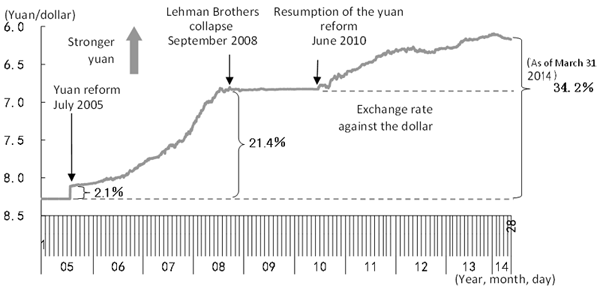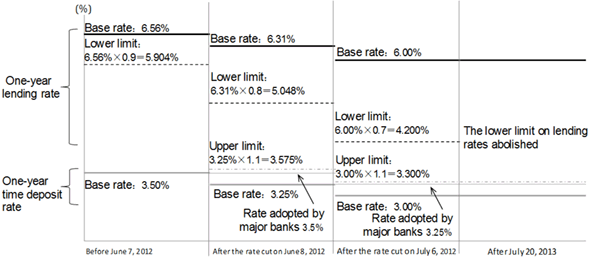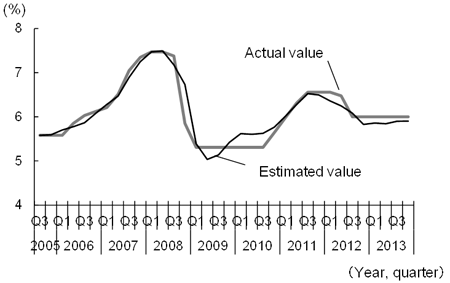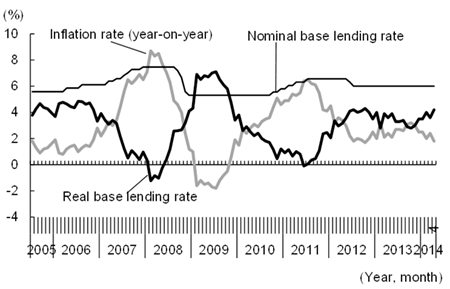Introduction
China is implementing a "trinity reform package" consisting of a shift of the yuan to a floating exchange rate system, the liberalization of interest rates, and the liberalization of capital transactions in preparation for opening up the country's financial markets. The Report of the 18th National Congress of the Communist Party of China held in November 2012 stated clearly that "We should … take steady steps to make interest rates and the yuan exchange rate more market-based, and promote the yuan's convertibility under capital accounts in due course." This policy was reconfirmed at the Third Plenary Session of the 18th Central Committee of the Communist Party held in November 2013. In the Report on the Work of the Government delivered at the National People's Congress held in March 2014, continuing to liberalize interest rates by granting financial institutions more power to set their interest rates, keeping the yuan exchange rate basically stable at an appropriate, balanced level while expanding its floating range, and promoting convertibility of the yuan under the capital account were included in the list of major tasks for the current year.
China shifted its exchange rate system from a de facto U.S. dollar peg of the past to a managed floating exchange rate system in July 2005. This was an important step toward a free floating exchange rate system in which the authorities, in principle, do not intervene in the currency market. The liberalization of interest rates, which was suspended after the collapse of Lehman Brothers, was resumed in June 2012 in the form of widening of the fluctuation range of deposit rates and lending rates of banks and other financial institutions. In addition, the People's Bank of China presented a roadmap consisting of three steps (short-, medium-, and long-term) for the liberalization of capital transactions in February 2012.
Shift of the yuan to the floating exchange rate system
With the aim of increasing the independence and the effectiveness of monetary policy and mitigating trade tensions with the United States, China has been looking to shift from a fixed exchange rate system to a floating exchange rate system. The effectiveness of monetary policy varies markedly depending on the degree of freedom in capital flows and the exchange rate system. As the "impossible trinity" theory in international finance advocates, it is impossible for any country to achieve the three goals of free capital flow, an independent monetary policy, and a fixed exchange rate at the same time (Table 1). For a long time, China was trying to maintain an independent monetary policy by limiting capital flows (giving up free capital flows), while maintaining a fixed exchange rate, under a de facto dollar peg system. However, as capital flows picked up with the internationalization of the yuan, the independence and the effectiveness of monetary policy (particularly interest rate policy) weakened. To stabilize the macro economy in this environment, there is no choice but to shift to the floating exchange rate system.
| Free Capital Mobility | Independent Monetary Policy | Fixed Exchange rate | Examples | |
|---|---|---|---|---|
| Capital Controls | ✕ | ◯ | ◯ | China (before July 2005) |
| Monetary Union | ◯ | ✕ | ◯ | Hong Kong, Members of Euro Area |
| Free Floating | ◯ | ◯ | ✕ | Japan, Australia |
| Managed Floating | △ | △ | △ | China (now) |
| Source: Compiled by the author. | ||||
Meanwhile, the United States has named unfair exchange rate manipulation as the cause of its significant trade deficit with China and is pushing for Beijing to allow the yuan to float more freely
In response to these domestic and overseas pressures, China revalued the exchange rate of the yuan against the dollar by 2.1% in July 2005 and shifted from the de facto dollar peg to a managed floating exchange rate system. China temporarily returned to the de facto dollar peg as an emergency measure around the time of the collapse of Lehman Brothers in September 2008, but reverted to the managed floating exchange rate system once again in June 2010, where it presently remains.
The managed floating exchange rate system which China operates at present is based on the BBC rules consisting of a band (a fluctuation range), a basket of currencies, and crawling (allowing the exchange rates to appreciate or depreciate at a pace under the authorities' control).
Under this system, the authorities announce the midpoint rate of the yuan against the dollar before transactions begin each day and limit the daily fluctuation range within a certain level above and below the midpoint rate. Initially, the fluctuation range was set at 0.3% above and below the midpoint rate but widened to 0.5%, 1.0%, and 2.0% above and below the midpoint rate on May 21, 2007, April 16, 2012, and March 17, 2014, respectively.
With respect to the basket of currencies, the authorities adjust the exchange rate (the midpoint rate) of the yuan, taking into account the fluctuations in the exchange rate of currencies of major trade partners against the dollar, while placing importance on the stability of the exchange rate of the yuan against the dollar. Through this adjustment, the authorities try to stabilize the effective exchange rate of the yuan.
Regarding the pace of crawling, the exchange rate (midpoint rate) of the yuan against the dollar rose has risen by about 35% since China shifted to the managed floating exchange rate system in July 2005 (Figure 1).

[Click to enlarge]
Under this managed floating exchange rate system based on the BBC method, the authorities have to intervene in the currency market repeatedly on a daily basis to keep the exchange rate within a given fluctuation range. Through changing the volume of the base money, this makes it difficult to control the money supply and reduces the effectiveness of monetary policy.
Looking at the situation in China today from the perspective of the theory of the "impossible trinity" theory in international finance, China has adopted an intermediate system in which some, but not complete, fluctuation in exchange rates is allowed, and capital flows have some, but not complete, freedom. Under this system, Chinese monetary policy maintains some, but not complete, degree of independence and effectiveness (see Box). To increase the independence and effectiveness of monetary policy, authorities will need to cease the daily announcement of the fluctuation range and the midpoint rate of the yuan and shift to the free floating exchange rate system in which they do not intervene in the currency market, in principle.
Liberalization of interest rates
In the market economy, interest rates, like exchange rates, are important "prices" that have a major influence on the allocation of resources. The liberalization of interest rates is an unavoidable challenge for China as it seeks to establish a market economy, for the following reasons.
First, the liberalization of interest rates will improve the efficiency of fund use. If interest rates are kept artificially low, demand for funds will exceed supply, and banks will allocate funds in a way that does not rely on the market principle. As a result, funds will tend to be concentrated on projects with low risk but low profitability. If interest rates are liberalized, banks will be able to set rates commensurate with borrower risk and increase lending to private-sector companies.
Also, as the deposit rates of banks are kept low through regulation, some funds looking for higher returns flow into informal channels that are beyond the supervision of the authorities (so-called shadow banking). However, if deposit rates rise with the liberalization of interest rates, that fund will flow back into the banking sector.
In addition, as banks are guaranteed a high margin under regulated interest rates, they do not have an incentive to develop new products and services. However, if interest rates are liberalized, competition in the banking sector will intensify, forcing banks to provide more diversified and better products and services.
Lastly, the liberalization of interest rates will strengthen the function of interest rates to guide the allocation of funds, and, consequently, investments will become more sensitive to fluctuations in interest rates, which in turn will increase the effectiveness of monetary policy.
In China, the liberalization of interest rates has been advanced gradually based on the principle of "money market and the bond market rates to precede deposit and lending rates," while the liberalization of deposit rates and lending rates has been promoted gradually based on the principle of "foreign currencies to precede the yuan," "lending rates to precede deposit rates," and "long-term rates on large loans and deposits to precede short-term rates on small loans and deposits."
The liberalization of interest rates in the money market and the bond market began in the late 1990s and is almost completed. Considerable progress also was made in the early 2000s on the liberalization of lending rates and deposit rates on foreign currencies. In addition, both the upper limit on lending rates of the yuan and the lower limit on deposit rates of the yuan were abandoned in October 2004, and the liberalization of large deposit rates also moved forward. Although the process of the liberalization of interest rates was suspended temporarily following the Lehman Brothers collapse, it was resumed in June 2012 in the form of widening of the fluctuation range of deposit rates and lending rates of banks and other financial institutions.
First, the People's Bank of China lowered yuan deposit rates and lending rates at financial institutions twice, on June 8, 2012 and July 6, 2012, and adjusted the fluctuation ranges at the same time. The one-year base lending rate was lowered by 0.56 percentage points in total (from 6.56% to 6.31% on June 8 and to 6.00% on July 6), and the lower limit on its fluctuation range was widened to 0.8 times the base rate on June 8 and to 0.7 times on July 6. Meanwhile, the one-year base time deposit rate was lowered by 0.5 percentage points in total (from 3.50% to 3.25% on June 8 and to 3.00% on July 6), and the upper limit on its fluctuation range was widened to 1.1 times the base rate. Subsequently on July 20, 2013, the lower limit on the lending rates of banks was abolished, but the upper limit on deposit rates was maintained (Figure 2).

[Click to enlarge]
These deregulations have allowed banks to determine freely their lending rates, which are no longer subject to any upper and lower limits. With respect to deposit rates, banks began offering deposit rates higher than the base rates set by the authorities, making use of their freedom to set rates within 1.1 times of the base rates. At the National People's Congress held in March 2014, Zhou Xiaochuan, the governor of the People's Bank of China, suggested that deposit rates would be completely liberalized within one to two years.
However, while the liberalization of interest rates provides many benefits, it could destabilize the overall financial system through adverse effects such as a deterioration in bank earnings, rises in the interest rate risk and credit risk, and fluctuations in deposits. To make maximum use of the benefits while containing the risks associated with the liberalization of interest rates, reforms such as the development of a deposit insurance system and the shift of monetary control from a quantitative approach to interest rate guidance are required, in addition to stronger bank governance, improvements in the level of corporate management, and the development of financing methods other than deposits.
Liberalization of capital transactions
China has adopted a cautious stance on the liberalization of capital transactions based on the judgment that its cost of destabilizing the macro economy could be greater than its benefits of higher investment efficiency and risk diversification. In reaction to the cautious approach to the liberalization of capital transactions in the past, a research team of the Financial Survey and Statistics Department of the People's Bank of China published a report titled "Conditions for Accelerating the Liberalization of Capital Transactions Have Almost Been Met in China" (hereinafter the "Report") in February 2012, and suggested that China should accelerate the liberalization of capital transactions.
The Report cited as reasons the following changes in the domestic and foreign environments. First, the global financial crisis has provided Chinese companies with an excellent opportunity to expand their business overseas, and, to support them, the liberalization of capital transactions is necessary. Also, as the liberalization of capital transactions contributes to the expansion of settlement in yuan in cross-border trade transactions and the development of the yuan offshore market in Hong Kong, it helps promote the internationalization of the yuan, which the government is promoting. In addition, the liberalization of capital transactions contributes to an urgent need for the structural reform of the Chinese economy through the overseas transfer of labor-intensive industries and the expansion of consumption due to higher investment income. Lastly, the effectiveness of regulations on capital transactions has fallen because of widespread use of illegal means such as disguising capital transactions as current transactions movements to get around capital regulations.
The Report demonstrates the following recognition about the current conditions in China: (1) the balance sheet of the banking sector is healthy; (2) foreign currency reserves are at a high level, (3) external debt, particularly short-term debt, has remained at a low level; and (4) risks in the real estate market and capital market are basically controllable.
On that basis, the Report presents a roadmap for the liberalization of capital transactions that consists of three steps over the next 10 years, adhering to the existing concept of the order of liberalization as follows: (1) capital inflows to precede capital outflows; (2) long-term transactions to precede short-term transactions; (3) direct investments to precede indirect investments; and (4) institutional investors to preceded individual investors.
| Short-term goal (1 to 3 years): | Encourage external investments of companies by relaxing regulations on direct investments under the principle of real (non-speculative) demand. |
| Medium-term goal (3 to 5 years): | Promote the internationalization of the yuan by encouraging deregulation of commercial loans related to trade under the principle of real demand. |
| Long-term goal (5 to 10 years): | Speed up the development of the financial market and open up investments in real estate, stocks, and bond transactions to foreign capital gradually and carefully by liberalizing capital outflows after liberalizing capital inflows. |
When this roadmap is fully implemented, the liberalization of capital transactions basically will be completed. Although regulations of certain transactions with a strongly speculative nature will remain, they will not get in the way of reasonable capital transactions between countries.
The Report also argues that China should move forward simultaneously with improving the soundness of the financial system, realizing the floating exchange rate system, and liberalizing interest rates, which are considered preconditions for the liberalization of capital transactions, instead of passively waiting for them to happen. By taking the sequencing of reforms into account, this roadmap, if implemented, should help China achieve the goal of liberalizing capital transactions without destabilizing the macro economy.
Toward that goal, People's Bank of China Governor Zhou Xiaochuan has pointed out the items described below as immediate measures to "promote the opening up of the capital market in both directions and increase the convertibility of cross-border capital and financial transactions in an orderly sequence" ("Accelerating the Development of the Financial Market System by Deepening the Reform and Opening Up of the Financial Industry across the Board," The People's Daily on November 28, 2013).
- Raise the maximum limit on investment by expanding the number of entities listed as Qualified Domestic Institutional Investors (QDII) and Qualified Foreign Institutional Investors (QFII).
- Allow all legitimate domestic and foreign organizations to make related investments by abolishing the QDII and QFII qualifications and the review, permission, and authorization of the maximum limit at the appropriate time.
- Gradually allow foreign companies that have met certain criteria to issue stocks in the Chinese capital market.
- Relax the qualification limit on bond issuance in yuan in China for foreign institutions.
- Liberalize capital transactions by individuals step by step, further facilitate the convertibility of transactions related to foreign direct investment (including withdrawal), and promote the convertibility of transactions related to financial derivatives under strict supervision.
The internationalization of the yuan, which the Chinese government has been promoting after the Lehman Brothers crisis, is also expected to progress in step with the liberalization of capital transactions. In addition, by the early 2020s when the liberalization of capital transactions is expected to be realized, the shift of the yuan to the floating exchange rate system and the liberalization of interest rates also should be completed. This should enhance the effectiveness of the monetary policy, particularly through adjusting interest rates.
Box: Effectiveness of Monetary Policy in China Constrained by the Managed Floating Exchange Rate System
Under China's current managed floating exchange rate system, rising capital mobility has sharply reduced the effectiveness of interest rates adjustment as a tool of monetary policy.
Although policy interest rates are raised (lowered) along with a rise (fall) in inflation and the growth rate, the adjustment is extremely small compared with changes in the inflation rate and the growth rate. For example, when the inflation rate rose from -1.8% in July 2009 to 6.5% in July 2011, the authorities raised interest rates five times, but the rate hike was only 1.25 percentage points in total. In fact, conducting regression analysis for the period after the yuan reform (from the third quarter of 2005 to the fourth quarter of 2013), the result shows that the one-year base lending rate of banks, which serves as a benchmark for policy rates, was raised by only 0.1 percentage point for each 1 percentage point rise in the inflation rate, and by 0.05 percentage point for each 1 percentage point rise in the growth rate (Figure a). Reflecting this, real interest rates (nominal interest rates – inflation rate) have a strong negative correlation with the inflation rate (Figure b). This is because the authorities are concerned that, under the current exchange system in which the authorities actively intervene in the currency market to stabilize exchange rates, a significant rate hike (rate cut) will actually cause an increase (a decrease) in liquidity through the expansion of capital inflows (capital outflows), rather than a decrease (an increase) in liquidity.
In this environment, reserve requirement adjustment has replaced interest rate adjustment as the most important tool of monetary policy in China. In fact, reserve requirements were raised 12 times by a total of 6 percentage points from January 2010 to June 2011 as a means to contain inflation, and the rate of increase in reserve requirements for major banks reached 21.5%. Following this, growth in money supply (M2) began to decline from the peak year-on-year growth rate of 29.7% in November 2009, and declined sharply after that.


The base lending rate is for one-year bank loans, and the quarterly figures are calculated as the average of the end-of-month values of the respective quarters.
Estimation period: 3Q/2005 to 4Q/2013



